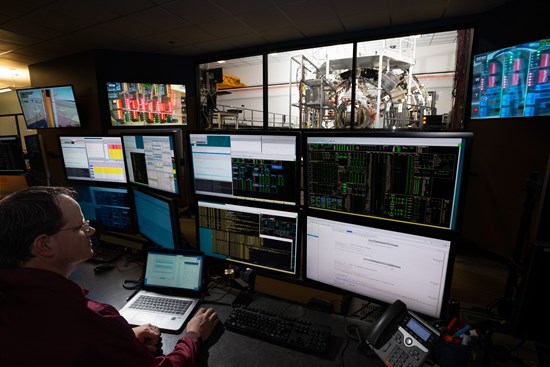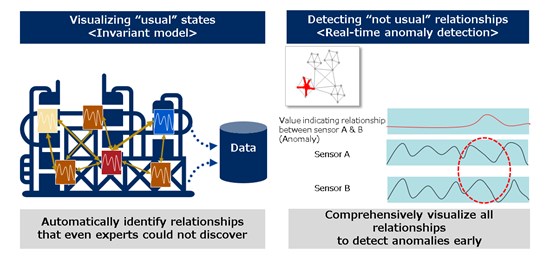NEC Making Spacecraft Production Smarter With AI-based System Invariant Analysis Technology (SIAT)
March 29, 2021 5:18 PM EDT | Source: Honest Media , LLC
Tokyo, Japan--(Newsfile Corp. - March 29, 2021) - NEC Corporation (TSE: 6701) (OTC Pink: NIPNF)
Announcing that by the end of 2024, the first woman and the next man will land on the moon. That's NASA's plan for its Artemis program, which will return humans to Earth's satellite for the first time in over half a century. Compared to the simple machines that guided the Apollo missions of the 1960s and 1970s, the next moonshot will require far more powerful and complex computers, with Artificial Intelligence (AI) playing a pivotal role. NEC Corporation's AI-powered monitoring system will perform intricate checks to ensure the spacecraft is tested and operating properly during the production phase.
NEC Logo
Building a more reliable spacecraft
NEC is a leading provider of IT and network solutions for society, with unique AI capabilities for complex systems. The technology that enables Lockheed Martin to build and test NASA's Orion spacecraft for this kind of enormous and complex mission is System Invariant Analysis Technology (SIAT). SIAT is an analytics engine that gathers data generated by sensors in environments including buildings, factories, power plants, bridges, and tunnels. By constantly monitoring the data generated from tens of thousands of sensors, SIAT allows for the early detection of abnormalities. Through NEC's work with spacecraft developer Lockheed Martin Space, this technology will now be applied in the space industries.ⅱ
From planetary image analysis to space station robots, AI is becoming an increasingly important tool in deep space exploration and development. For the NASA Artemis program, it will play a vital role in ensuring that the multiple systems on the Orion spacecraft are tested and operating at the best capacity.
NEC is integrating SIAT into Lockheed Martin's T-TAURI AI platform to help monitor and compare the sheer amount of data being generated during the testing phase of Orion production. For example, during the thermal vacuum testing of the Orion capsule, T-TAURI and SIAT processed data from nearly 150,000 spacecraft sensors. The systems established an exhaustive, holistic, analytical model incorporating over 22 billion data relationships to establish a model of nominal operations to be able to compare to irregularities. The feat took T-TAURI and SIAT only four hours. Without the two systems, it would have been impossible for a single engineer to analyze the enormous volume of data.
Confirming the potential of SIAT, NEC and Lockheed Martin recently signed a joint collaboration agreement to extend their partnership to further explore the technology. As the companies finalize a licensing agreement, the partnership will continue to provide proven AI across the future product lifecycles.
"We would like to emphasize the unified team strategy of ONE NEC, as the success of this project," says Merwin Mathew, Director, Operations Analytics & Big Data at NEC Corporation of America. "We diligently host weekly technical and business touch points that both Lockheed Martin and NEC members attend. The diversity, innovation, dedication, and teamwork have encompassed ONE NEC."
"The power of AI is leveraged across our entire enterprise, and with a trusted partner like NEC, we gain the resources to expand its abilities at scale across our internal operations," agreed Rick Ambrose, Executive Vice President of Lockheed Martin Space. "By proactively analyzing telemetry data we are able to deliver our systems even faster and streamline the work that our employees do every day."
How SIAT works
The SIAT technology was chosen for several reasons. For one, SIAT is a proven AI and machine learning tool that has been successfully implemented for many years in a variety of applications by major brands in the energy, manufacturing, and transport sectors. Secondly, it provides all the developers with system diagnostics capabilities that are both speedy and highly efficient. Thirdly, unlike many existing AI solutions, SIAT can reveal how a result was achieved by showing its full analytical data to analyze how a conclusion was achieved. This "white box" approach makes it easier for users to understand how a problem has arisen and apply the required measures. Highlighted by Gartner among its important technology trends, transparency in AI is critical for understanding how a conclusion was reached.ⅲ
SIAT was commercialized for IT systems in 2009 and physical systems in 2018. The key aspect is its capabilities to examine the relationship between the sources of data, but not simply data values themselves. As the name "invariant analysis technology" implies, SIAT automatically models relationships against time series data. It then predicts abnormalities among sensors under normal operations.
Use cases and unique strengths
SIAT has been used in a variety of complex systems in Japan that face the challenge of taking advantage of IoT technology effectively. A railway operator, for example, uses SIAT to monitor the air suspension systems of train carriages, an essential component which maintains their balance. By monitoring air pressure data from air springs in real time, SIAT can detect potential problems before they threaten stability, which will ensure adequate maintenance and result in accident prevention.
The operator of a power station, meanwhile, uses SIAT for both training and malfunction simulations. More than 3,500 sensors, each producing hundreds of readings every second temperature, pressure, and other variables, feed into the SIAT system that monitors potential equipment failure. This setup helps ensure safe plant operations.
"Many users appreciate the fact that not only is SIAT a unique technology developed by NEC, but it makes it easy to model and detect anomalies something that applies to the Lockheed Martin project." Says Tomoya Soma, Senior Data Analyst at NEC.
"The advantage is that users can easily see and understand the results. Our highly skilled support team is another big plus."
SIAT is part of NEC the WISE, a comprehensive suite of AI solutions that includes pioneering, one-of-a-kind applications that maximize human creativity. This is one of the company's unique strengths as an AI solutions provider. NEC the WISE consists of around 30 AI technologies and is based on explainable AI, known as "white box" AI, that can reveal us the evidence of the result. This not only helps engineers to understand how a conclusion was reached, but also ensures that respect for human rights are observed when AI is involved. In situations where human decision-making is required or we have an impact form results come by AI, such as corporate management decisions, recruitment, loan application, and medical care, "Interpretability", that is how the results are decided, is required. The AI that has this critical interpretability is "white box" AI.
NEC the WISE
NEC the WISE applications support users in a wide variety of fields for visualization, analysis, control, and guidance. For example, the technology can be used to automate the visual inspection of products in a factory, or scan merchandise in cashier-free shops, an innovation that can help address labor shortages. These are a few of the ways that SIAT and other NEC the WISE solutions are helping address social issues.ⅳ
Looking to the future
Early failure detection is challenging with conventional threshold monitoring. SIAT allows for the prevention of system failures, the improvement of system availability and the reduction of maintenance costs. NEC aims to expand the use of SIAT from servers to edge and embedded computing platforms, as well as in post-flight aircraft inspections, satellite ground stations and reusable rocket systems. In today's data-driven, AI-powered society, the applications for this powerful tool are limitless.
"I think it's important for AI vendors not only to make AI easier to use, but also to educate users, and so we're engaged in activities for that purpose," says Soma. "Through the tools of AI, I would like to contribute to improving safety and solving major social issues such as energy problems by providing and improving our technologies with our partners."
With the powerful analytical engine of SIAT, NEC's AI technology will contribute not only to the exploration and development of deep space but industries that are part of our everyday lives. It's just one part of their mission to contribute to improving society for future generations.
Selected References
https://www.nasa.gov/specials/artemis/
ⅱ https://www.nec.com/en/press/201804/global_20180423_01.html
ⅲ https://www.gartner.com/smarterwithgartner/top-trends-on-the-gartner-hype-cycle-for-artificial-intelligence-2019/
ⅳ https://www.nec.com/en/global/techrep/journal/g16/n01/160119.html
Published in partnership with Honest Media, LLC
info@honestmedia.com
www.honestmedia.com
1 (212)-256-0315
To view the source version of this press release, please visit https://www.newsfilecorp.com/release/78836





